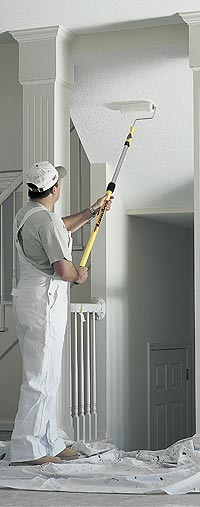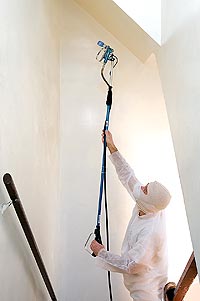
Specialty Tools for Vaulted Ceilings, Painting Vaulted Ceilings
The Franklin Bender is a pivot tool that can be positioned in any angle at the push of a button. It can hold any type of roller and can be used with spray shields, brush holders, knock-down texture knives and pole sanders.
by Stacey Enesey Klemenc
, a vaulted ceiling can be a bear to paint unless you’re properly armed to tackle it.
Fortunately, ladders and a long reach are not the only aids out there to help you do a top-notch job. Today’s professional painter has several specialty tools from which to choose. Many not only save time but also help keep the painter’s feet planted firmly on the ground — and up the profit margin considerably.
Invented by Ron Franklin of Sacramento, the Franklin Bender is a pivot tool that can be positioned in any angle at the push of a button. It is designed to fit Wooster Sherlock Positive Lock and Sherwin Williams Pin Lock extension poles. Besides being able to hold any type of roller, the tool can be used with spray shields, brush holders, knock-down texture knives and pole sanders.
Franklin says he got the idea for a multi-positioned roller when he was painting tract housing in his area and an increasing number of houses had high vaulted or cathedral ceilings. The constant ups and downs on a ladder — and the amount of time he had to spend up high cutting in — were making a dent in his production schedule.
 He began experimenting with a pivot tool at the end of an extension pole and soon realized if he adjusted the roller a certain way he could roll horizontally rather than vertically along the walls close to the ceiling. “I could get within an inch of the ceiling rather than the five inches I would leave rolling vertically,” says Franklin, who’s been in the painting business nearly 30 years. “When you add up all those inches in all the houses you paint, you’ll realize the Bender is a real time saver. This tool will quickly pay for itself.” He began experimenting with a pivot tool at the end of an extension pole and soon realized if he adjusted the roller a certain way he could roll horizontally rather than vertically along the walls close to the ceiling. “I could get within an inch of the ceiling rather than the five inches I would leave rolling vertically,” says Franklin, who’s been in the painting business nearly 30 years. “When you add up all those inches in all the houses you paint, you’ll realize the Bender is a real time saver. This tool will quickly pay for itself.”
Besides saving on brush time, the Bender also allows you the versatility to reach more places from the floor, rather than from a ladder or something else in the room. Because of its maneuverability, it’s also a handy tool to have when you’re painting in a small area, such as a hallway, that has a high ceiling.
So far, Franklin says, he hasn’t had a dissatisfied customer. “If a user takes care of this tool,” which is made out of high-quality aluminum and retails for $90, “it will last an entire paint career,” he says. It’s made in the U.S.
According to Bob Clemence, director of new product sales for Hyde Tools Inc. in Southbridge, Mass., his company now offers a spray gun extension pole called AnglePRO. Available in 3-foot or 5-foot lengths, this new line of spray extensions has a slide handle that allows you to adjust the head 145 degrees with a single smooth motion.
“You can swivel the angle of tip while painting and can always keep it 90 degrees on the surface. It’s beautiful for vaulted ceilings,” Clemence says. “You use less paint and less time. Also, because of the extension you don’t have to move the staging as often.”
AnglePRO will work with any standard spray gun. The 3-foot pole retails for $235 and the 5-foot retails for $259.
A novel tool from Full Circle International, the Radius 360° — with its side-to-side, up-and-down and circular mobility — features a full 9-inch diameter, die-cast aluminum head with wide pivot brackets. Used for drywall sanding, it virtually eliminates flipping, surface scratching and gouging.
Unlike conventional pole sanders, the half-inch-thick foam disc on the Radius 360º wears evenly, so it lasts longer. Plus, it enables the user to change directions quickly without having to lift the pad off the wall. The foam pad and the sandpaper are attached with hook-and-loop backing, making for easy replacement.
A company spokesman says sanding with the Radius 360° is up to three times faster than with a conventional sand pole. And it’s much more convenient for a variety of situations, including vaulted ceilings. Perhaps its most defining quality is its ability to sand curved surfaces. It also eliminates hand sanding on 90-degree corners and the streaking from a hand-held sponge. It can also be used for sanding in between coats. The tool retails for $35.
Available from the company that has manufactured telescoping extension poles since 1958, the AlumiGlass from Mr. LongArm features a smooth composite fiberglass handle and aluminum tube for balance. “You can put any threaded tool on the end of this extension pole,” notes Melodie Wendleton, director of creative services for the Missouri-based company.
The two-section 6-foot to 12-foot pole sells for $20 and the three-section 8-foot to 24-foot pole sells for $40. Both are made in the U.S.
Glazing has just gotten easier, thanks to a new tool now available from Barth’s Faux Studio in Las Vegas. “The Faux Tool is going to be the new revolutionary tool for people using glazes,” says Barth White, studio owner and inventor. “I invented it because we needed something to speed things up.” This tool, he adds, not only makes manipulating glazes four to five times faster but also gives glazes a more consistent, even look.
“You’ll be able to work a complete wall or ceiling and the glaze will stay wet. There won’t be those [unsightly] dry lines,” he says.
Whereas the Faux Tool is designed to manipulate, mottle and move glazes around, it has been successfully used to apply glazes as well. “Its uses are limited only by your imagination,” White says.
The tool, which weighs less than a pound, comes with an extension pole and three sleeves made out of terry cloth, plastic and lamb’s wool. Also included in the package are a quart of glaze and an instructional video, as well as a $200 coupon which can be used toward a class at Barth’s Faux Studio or one of its participating schools. The Faux Tool retails for $100.

|

